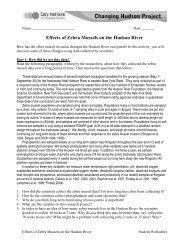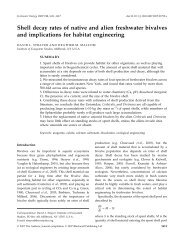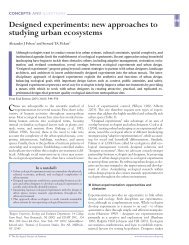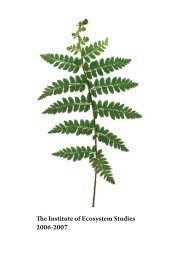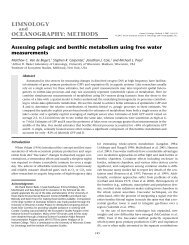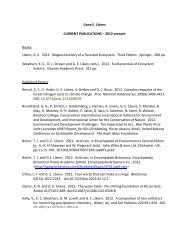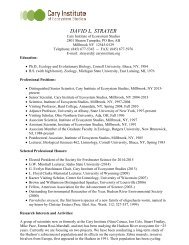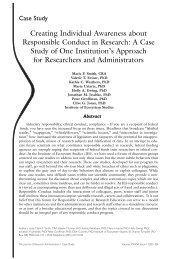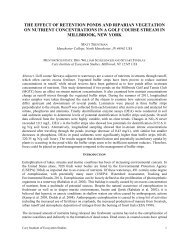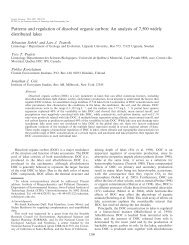Patch dynamics in a landscape modified by ecosystem engineers
Patch dynamics in a landscape modified by ecosystem engineers
Patch dynamics in a landscape modified by ecosystem engineers
You also want an ePaper? Increase the reach of your titles
YUMPU automatically turns print PDFs into web optimized ePapers that Google loves.
dra<strong>in</strong><strong>in</strong>g of a pond and exposure of accumulatedsediments follow<strong>in</strong>g abandonment of a site and subsequentdam failure.In the model, beaver ponds with a resident colony areconsidered as active patches (A). Typically, only theoldest pair of beaver <strong>in</strong> a colony will reproduce,produc<strong>in</strong>g on average 3 or 4 young annually (Jenk<strong>in</strong>sand Busher 1979). Colonies typically consist of an adultpair, yearl<strong>in</strong>gs, and kits, with an average size of 5.859/0.61 (SE) <strong>in</strong>dividuals (Svendsen 1980). Young beaverdisperse at about 2 or 3 years of age (Jenk<strong>in</strong>s and Busher1979, Svendsen 1980), although if food supplies areplentiful or local population densities are high, as manyas 50% of two-year old beaver can rema<strong>in</strong> at their natalcolony (van Deelen and Pletscher 1996). Dispersaldistances tend to be less than 16 km (Beer 1955, Leege1968), but distances of up to 110 km have been reported(Hibbard 1958). Mortality dur<strong>in</strong>g dispersal tends to behigh relative to non-dispers<strong>in</strong>g beaver, with mortalityrates of 40% be<strong>in</strong>g reported for the 1.5/2.5 year class ofbeaver <strong>in</strong> Newfoundland (Payne 1984). Birth rates percolony, site fidelity and mortality dur<strong>in</strong>g dispersal areimportant factors <strong>in</strong> determ<strong>in</strong><strong>in</strong>g the model parameter n,or the per patch production rate of successful colonists.Although these factors are likely to vary across the rangeof beaver, if one assumes the figures reported above arestandard for beaver across their range, one can estimatea value for n of 0.7 successful immigrants per year.It is also possible that the creation of active patchesmay be affected <strong>by</strong> the presence of colonies of beaverthat occur <strong>in</strong> sites that do not require habitat modification.Beaver are known to build lodges on naturallyoccurr<strong>in</strong>g lakes and ponds as well as <strong>in</strong> the banks oflarger rivers without perform<strong>in</strong>g any significant eng<strong>in</strong>eer<strong>in</strong>g.In <strong>landscape</strong>s where such patches are present,the number of successful colonists that are produced <strong>by</strong>these non-eng<strong>in</strong>eered sites (i) will <strong>in</strong>fluence the rate atwhich new active patches are formed. Although it ispossible that the number of colonists com<strong>in</strong>g from noneng<strong>in</strong>eeredpatches is not constant and might depend onthe number of eng<strong>in</strong>eered patches <strong>in</strong> a <strong>landscape</strong>, tosimplify analysis of the model, we have assumed aconstant rate of immigration.Over time, active colonies deplete the food resourcesadjacent to the pond, ponds fill with sediment, andresident beaver die eventually lead<strong>in</strong>g to abandonment.The rate at which this occurs (d) will be a function ofcolony size, beaver activity, the composition and abundanceof riparian zone trees or other food resources, andsediment loads of dammed streams. Knudson (1962)reported that beaver ponds may rema<strong>in</strong> active for as longas 8/10 years, while <strong>in</strong> Algonqu<strong>in</strong> Prov<strong>in</strong>cial Park,Canada, sites were occupied for an average of 5.89/0.46 (SE) years over a ten year period (Fryxell 2001).Once ponds are abandoned, they develop <strong>in</strong>to wetlandswith variable hydrologic regimes and vegetation composition(Remillard et al. 1987, Johnston and Naiman1990c, McMaster and McMaster 2000, Wright et al.2002). The sites rema<strong>in</strong> <strong>in</strong> this state (equivalent todegraded, D, patches) until the vegetation <strong>in</strong> the areaadjacent to the former pond site has recovered to adegree sufficient to support a new beaver colony. Therate at which this transformation from D patches to Ppatches occurs (r) depends on the successional <strong>dynamics</strong>of the forests surround<strong>in</strong>g pond sites.In most areas, once beaver have colonized a site, thesite enters <strong>in</strong>to a pattern of cyclic abandonment andrecolonization. It is relatively rare for a site that has beencolonized <strong>by</strong> beaver to revert back to a forested riparianzone (equivalent to the F state <strong>in</strong> the more complexpatch dynamic model, Ives 1942, Remillard et al. 1987,Johnston and Naiman 1990a, Pastor et al. 1993,Terwilliger and Pastor 1999), thus the parameter r islikely to be extremely low <strong>in</strong> most <strong>ecosystem</strong>s affected <strong>by</strong>beaver. The degree to which beaver prefer or avoid sitesthat have been previously colonized relative to forestedriparian zone (z) will aga<strong>in</strong> depend on the successional<strong>dynamics</strong> of the riparian zone vegetation. In many areas,recently abandoned sites are dom<strong>in</strong>ated <strong>by</strong> species ofSalix, Populus and Alnus, preferred food species ofbeaver (Jenk<strong>in</strong>s and Busher 1979). The situation whereherbivores, such as beaver, create environments favorablefor the growth of early-successional species, which areoften preferred <strong>by</strong> beaver, has been termed the retardedsuccession hypothesis (Pastor and Naiman 1992). However,it is also possible for beaver forag<strong>in</strong>g to facilitate thedom<strong>in</strong>ance of conifers and other late-successional speciesthat are typically avoided as food sources, (theaccelerated succession hypothesis, Fryxell 2001).Furthermore, it has been shown that brows<strong>in</strong>g <strong>by</strong> beavercan <strong>in</strong>crease rates of phenolic glycoside production <strong>in</strong>Populus fremontii (Mart<strong>in</strong>sen et al. 1998). If suchchemical defenses aga<strong>in</strong>st mammalian herbivory persistor brows<strong>in</strong>g <strong>by</strong> beaver leads to dom<strong>in</strong>ance of nonpreferredspecies, sites that have been previously occupied<strong>by</strong> beaver might be avoided.Beaver activity on the Hunt<strong>in</strong>gton Wildlife Forest(HWF) has been surveyed annually s<strong>in</strong>ce 1979. TheHWF is a 6000-hectare preserve located <strong>in</strong> the centralAdirondack Mounta<strong>in</strong>s, NY (latitude 44800?N, longitude74813?W). The topography is mounta<strong>in</strong>ous withelevations rang<strong>in</strong>g from 457 m to 823 m. Vegetationconsists of mixed northern hardwood and coniferousforest. As part of the Adirondack Long Term Monitor<strong>in</strong>gProject (ALTEMP), all active beaver sites on HWFhave been identified and mapped every fall s<strong>in</strong>ce 1979.Although the number of colonies has fluctuated overtime (Fig. 2), the number of beaver colonies hasrema<strong>in</strong>ed relatively constant, particularly s<strong>in</strong>ce 1990.Although there is some variability <strong>in</strong> the numbers of<strong>in</strong>dividuals per colony, colony counts can provide auseful estimate of population sizes for beaver (BergerudOIKOS 105:2 (2004) 339



